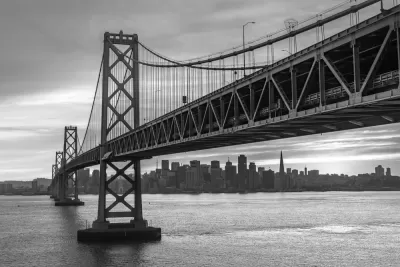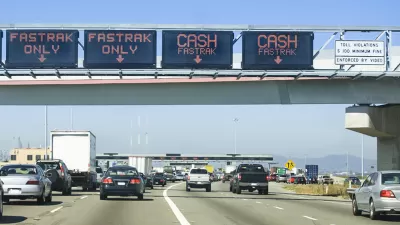A California taxpayers association has challenged the June passage of a regional ballot measure because it didn't receive two-thirds support from voters, although two prior voter-approved bridge toll increases also fell short of a super-majority.

On June 5, over 55 percent of voters in nine Bay Area counties approved Regional Measure 3 (RM 3), sponsored by the Metropolitan Transportation Commission (MTC), to hike tolls on seven state-owned bridges by $3 over six years, funding over $4.5 billion in transportation capital projects and transit operating costs over 25 years. [See expenditure plan (pdf)].
"The Howard Jarvis Taxpayers Association filed the suit Thursday [July 5] in San Francisco Superior Court against the Bay Area Toll Authority [overseen by MTC]" reports Erin Baldassari for The Mercury News on July 9.
It challenges the notion that Regional Measure 3, which voters approved last month [also posted here with state ballot measure results], is a “fee” requiring only a simple majority to pass, rather than a “tax,” which requires two-thirds voter approval. The suit asks that the toll be invalidated.
In some ways, the lawsuit [pdf] bears similarity to Proposition 6, the gas tax repeal initiative that California voters will decide on November 6, in the sense that it challenges the approval of a multi-billion funding program, whether by voters (RM 3) or their legislative representatives (Senate Bill 1, the Road Repair and Accountability Act of 2017), based on increasing user fees that are subsequently challenged by tax opponents.
The Jarvis association objects to the majority of toll revenues not benefiting toll-payers directly, which they claim makes it more of a tax than a fee. According to an earlier email to Planetizen from MTC, "the final mode split (including operating funds) is 69% transit, 25% highway (interchange improvements, express lanes and some safety projects), 3% multimodal (goods movement/mitigation) and 3% bike/ped." [Also see FAQ on the measure (pdf)]
Defending the expenditure plan, Jim Wunderman, the president and CEO of the Bay Area Council, an organization that represents businesses in the region and one that helped campaign for the measure, stated:
"Regional Measure 3 will effectively add greater capacity to our bridges by … improving and expanding critical regional mass transit systems and providing other good alternatives like bicycling and walking.”
Timothy Bittle, Director of Legal Affairs for the Howard Jarvis Taxpayers Association, also cited Proposition 26, "Supermajority Vote to Pass New Taxes and Fees (2010)," as another argument supporting the suit, adds Baldassari.
Fees that benefit the public broadly — rather than providing services directly to the fee payer, such as garbage fees or state park entrance fees — would be considered a tax under Prop 26, the state Legislative Analyst's Office said.
Regional Measures 1 and 2, which also increased tolls on the same, seven state-owned bridges, were approved by voters in 1988 and 2004, respectively. In addition to preceding Prop 26, more of the toll revenue went to the bridges and highways in capital improvements. However, Wunderman expressed confidence that "the suit will be dismissed or defeated in court."
Related posts from Planetizen archives:
-
November 23, 2010In California, passage of Proposition 26 has raised the question of whether fees used for public services will be jeopardized at the local level. Some argue most fees will be unaffected, but others could take a hit.The Sacramento Bee
-
November 8, 2010While Propositions 19 (marijuana) and 23 (global warming suspension) grabbed headlines, Prop 26, which would require a 2/3rds vote threshold for fees, slipped under the radar and passed. Opponents say it could make regulation nearly impossible.The New York Times - Energy & Environment
Hat tip to MTC News Headlines.
FULL STORY: Lawsuit targets toll authority over $3 bridge toll increase

Study: Maui’s Plan to Convert Vacation Rentals to Long-Term Housing Could Cause Nearly $1 Billion Economic Loss
The plan would reduce visitor accommodation by 25,% resulting in 1,900 jobs lost.

Alabama: Trump Terminates Settlements for Black Communities Harmed By Raw Sewage
Trump deemed the landmark civil rights agreement “illegal DEI and environmental justice policy.”

Why Should We Subsidize Public Transportation?
Many public transit agencies face financial stress due to rising costs, declining fare revenue, and declining subsidies. Transit advocates must provide a strong business case for increasing public transit funding.

Paris Bike Boom Leads to Steep Drop in Air Pollution
The French city’s air quality has improved dramatically in the past 20 years, coinciding with a growth in cycling.

Why Housing Costs More to Build in California Than in Texas
Hard costs like labor and materials combined with ‘soft’ costs such as permitting make building in the San Francisco Bay Area almost three times as costly as in Texas cities.

San Diego County Sees a Rise in Urban Coyotes
San Diego County experiences a rise in urban coyotes, as sightings become prevalent throughout its urban neighbourhoods and surrounding areas.
Urban Design for Planners 1: Software Tools
This six-course series explores essential urban design concepts using open source software and equips planners with the tools they need to participate fully in the urban design process.
Planning for Universal Design
Learn the tools for implementing Universal Design in planning regulations.
Smith Gee Studio
Alamo Area Metropolitan Planning Organization
City of Santa Clarita
Institute for Housing and Urban Development Studies (IHS)
City of Grandview
Harvard GSD Executive Education
Toledo-Lucas County Plan Commissions
Salt Lake City
NYU Wagner Graduate School of Public Service





























